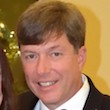|
Forrest Warthman John Goetz Rob Johnson Martin Morf
Forrest Warthman
Forrest wrote Cities and Computers: Their Architecture, which compares the functions of architectures in computers and cities. He gave presentations of this book at the University of California Berkeley and Stanford University. In addition to writing, Forrest has designed or led the development of six product prototypes, including prototypes for a flat-panel drawing device, a cost-accounting application marketed with Microsoft, a file-conversion application, two audio synthesizers based on Intel neural-network chips, and several Java animations. Forrest received an M.A. in Architecture and an M.A. in City Planning from the University of California at Berkeley. His city-planning thesis was written under the chairman of the EE/CS Department. He received his B.S. in Design from the University of Michigan. John Goetz
Prior to Warthman Associates, John was at IBM for 23 years, most recently as a senior engineer in IBM's Global Engineering Solutions (GES) architecture group, where he architected embedded imaging solutions based on the Cell multiprocessor and ASICs for the aerospace, defense and health care industries, including CT, PET, MR, and ultrasound technologies. Before that, he taught high-school mathematics and wrote standard specifications for the RapidIO Trade Association. He was a senior engineer and marketing manager for IBM's Network Processor Business Line, where he defined new PowerPC-based products and positioned existing products for network applications. Before that he was a senior processor architect working on product strategy of system-on-chip (SoC) PowerPC products and x86 business relationships. He architected and led the verification of an operating mode for the PowerPC 615 processor that executed multiple instruction sets, and he served as the in-house consultant to IBM design and verification teams on all issues related to PowerPC and x86 instruction-set architectures. He was the principal editor of the engineering specification for the PowerPC 615 processor. Prior to that he managed the department responsible for IBM’s x86 processor architectures and verification. He began his career at IBM in electronic design automation (EDA), responsible for developing simulation and logic-synthesis tools. He has five patents in areas including microprocessor cache design, multiple-instruction-set support, and logic-network optimization. John received his B. S. in Electrical Engineering from University of Notre Dame, followed by masters coursework in microprocessor architecture and operations research at the University of Vermont. Rob JohnsonRob Johnson is an engineer and technical writer specializing in
consumer-electronic product development. He has written many technical and developer documents for graphics
processors, I/O
chipsets, wireless network devices, process development, and software-quality
engineering.
Before joining Warthman Associates, Rob worked at Intel where he
developed software for new chipsets including the Intel®810
graphics and early Centrino™ wireless products. He architected
and coded the video-capture drivers and interrupt subsystems for
the graphics chipsets as well as bringing up the hardware. He also
authored protocol-analyses and architecture proposals for Intel’s
integrated wireless products. He was directly responsible for developing
and writing programmer’s reference manuals for multiple chipsets,
training materials for software-process improvement and innumerable
reports, proposals, and other engineering documents, as well as leading
product-development teams for Linux drivers. At GTG Productions,
Rob created software for enhanced CDs that included disc and audio
control and installers for such artists as David Bowie, Brian Eno,
and Todd Rundgren. He also developed programmable high-performance
ignition systems for Yamaha jetskis and an audio mixer plug-in for
Macromedia Director®. Prior to GTG Productions,
Rob developed toys for Hasbro®, Lionel®,
and Chase Toys, including a GI Joe playset and the TrainMaster® Command
Control system which was debuted at the Asilomar Microcomputer Conference.
Previously, he was chief engineer for C & K Systems’ System238™ Residential/Commercial
Security Panel, developing the hardware, software, and communication
architectures as well as the product requirements, user’s guide,
and product datasheet.
Rob attended Virginia Tech and Hayward State Universities before receiving his B.S. in Electrical Engineering from the University of Nevada, Reno. He has also taken coursework in program management, Linux driver development, software-development life cycles, patent development and product branding and trademarking. Rob is a cycling enthusiast, having ridden all over the world including the 2003 Tour de France route. Martin MorfMartin Morf is a content consultant to Warthman Associates' writers. He is an expert in the theory of information, control, estimation, and computer architecture. He is active in research on smart photonic networks, parallel and adaptive computing, specialized coprocessors (fluid-flow, communications, real-time control, and DSP), micro-MRI informatics, brain imaging, electro-optical and quantum devices, sub-nanosecond arithmetic processing, and information-preserving transformations. He has participated in a wide variety of research projects, most recently in projects that bring together the disciplines of biology, information technology, microelectronics, and physics. He has been Visiting Professor of Electrical Engineering at Stanford University, Codirector of the Stanford Computer Architecture and Arithmetic Group, Professor of Computer Science at ETH Zurich, Professor of Electrical Engineering and Computer Science at Yale University, and Visiting Professor at several institutions including NASA/Ames Research Center, Stanford University's Center for Integrated Systems, Xerox PARC, IBM T.J. Watson Research Center, and ETH Zurich's Institute for Control, Institute for Biomedical Engineering, and Institute for Mathematics. He has also conducted research projects for Canon Research America, Xerox PARC, RCA, and Chevron Research. Early in his career, he served in the Swiss Army Signal Corps. He has authored or coauthored over 250 publications, including recent publications on reconfigurable and adaptive computing, photonic modulation and routing, computing-system optimization, estimation theory, nanotechnology architectures, and speech modeling. Martin received his Federal Diploma in Electrical Engineering at ETH Zurich, and his M.S. and Ph.D. in Electrical Engineering at Stanford University. He also received an honorary M.A. from Yale University.
|





 Forrest Warthman is the founder of Warthman Associates. He works as the company's principal writer, editor, and project
manager.
He
personally wrote many of the documents listed
on the
Forrest Warthman is the founder of Warthman Associates. He works as the company's principal writer, editor, and project
manager.
He
personally wrote many of the documents listed
on the  John Goetz has had a 23-year career at IBM as a microprocessor and computer-system architect, product
marketing
manager, verification-tool developer, and logic designer. He has
written technical manuals and engineering specifications throughout his
career, including documents about the Cell Broadband Engine (CBE), PowerPC, x86, and MIPS processor
architectures, network processors, and reconfigurable logic. At Warthman Associates, John has written
technical documents for Arm, AMD, PMC-Sierra, and Xilinx about the Arm, x86, PowerPC, and MIPS processor
architectures, and for Infineon about industrial semiconductors.
John Goetz has had a 23-year career at IBM as a microprocessor and computer-system architect, product
marketing
manager, verification-tool developer, and logic designer. He has
written technical manuals and engineering specifications throughout his
career, including documents about the Cell Broadband Engine (CBE), PowerPC, x86, and MIPS processor
architectures, network processors, and reconfigurable logic. At Warthman Associates, John has written
technical documents for Arm, AMD, PMC-Sierra, and Xilinx about the Arm, x86, PowerPC, and MIPS processor
architectures, and for Infineon about industrial semiconductors.